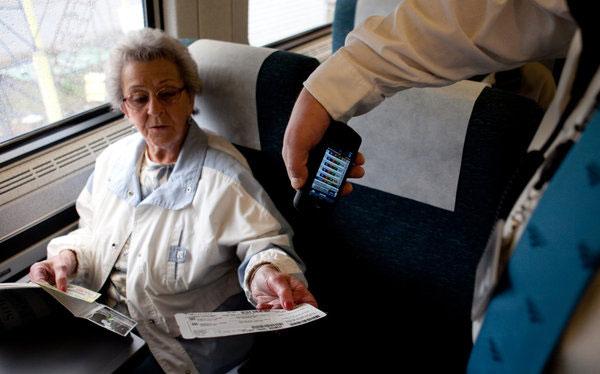Amtrak, which is owned by the U.S. government and has more than 20,000 employees, began issuing iPhones to train conductors last November, according to The New York Times. By late this summer, the company plans to have a total of 1,700 conductors using iPhones to scan tickets across the country.
The company, which oversees American railroad train services, invested $7.5 million in its new iPhone-based ticketing system. Most of the cost — $5.5 million — came from developing the software, while the remaining $2 million cost is related to hardware.
The new system will allow customers to print their own tickets, or load tickets on their smartphone. The barcode included with a paper or digital ticket can be scanned by a modified iPhone, outfitted with a scanner and a special application.
Each conductor's iPhone includes a special internal case that not only includes the scanner, but also houses an external battery that allows the device to last longer. That's similar to Apple's own iPod touch-based EasyPay checkout system, which the company utilizes in its retail stores.
Amtrak's included software also allows conductors to inform staff that a disabled passenger is getting off the train at a particular stop, so they can coordinate the track and wheelchair lift. Conductors can also use the iPhone to conveniently report equipment failures, such as broken toilet fixtures.
Photo by Craig Dilger of The New York Times.
The new system will also allow customers to more easily book or modify reservations. The Times gave an example of a customer who could change their ticket online or through Amtrak's iPhone application, instead of receiving a refund for a ticket and buying a new one.
Amtrak currently has an application for the iPhone on Apple's App Store, which allows ticketing services and other benefits. The company is said to be working on an Android application that will launch this fall, while Amtrak's website can also be accessed by users on mobile devices.
 Katie Marsal
Katie Marsal







-m.jpg)






 Bon Adamson
Bon Adamson
 Marko Zivkovic
Marko Zivkovic
 Amber Neely
Amber Neely
 Malcolm Owen
Malcolm Owen


 Christine McKee
Christine McKee



-m.jpg)






15 Comments
Amtrack is pretty much bankrupt.
Do they make good business decisions?
I noticed this last week while riding the train. It doesn't make ticket collection any faster.
Amtrack is pretty much bankrupt.
Do they make good business decisions?
Not enough. Hopefully this is one of them, only time will tell.
It's the same with any business. They all have to make a variety of business decisions, some more important than others and nobody chooses correctly 100% of the time. As a matter of fact, it's the same with a person. People make choices, hopefully they don't make too many ones that will ruin their lives.
I'm not terribly surprised that you have yet to come to this realization though.
$5.5 million for scanning software seems a bit much. Aside from the hardware cost, I don't see why this would have cost them more than a $ few hundred thousand, even working with a legit enterprise software developer. I'm not one of these people who thinks Government can't do anything right, but it seems like every Government contractor is riding the sweet train to riches.
On the other hand, Amtrak rode 30.2 million passengers in 2011, so the total cost of $7.5 million is only 25 cents per passenger and that's only for one year. (I'm assuming that the 30.2 million represents tickets, not passengers. If they really sold 60 million tickets, then we're only talking about 12 1/2 cents per ticket.)
In defense of Amtrak's budgeting decisions it may be helpful to know that Amtrak sort of has its hands tied on spending. The federal government (rightly, I strongly believe) doesn't want them collapsing so has given them money but then ties conditions to how that money is spent. Presidents from both parties have tried to make proposals about bringing vitality to national rail travel. Here's an old article which explains. It's a bit sad that conditions haven't improved much since (though the Acela is running).
http://www.nytimes.com/2005/06/12/weekinreview/12wald.html
The hard working conductors don't use any mobile tech. Rail travel is really great and I wish it were more viable and that it was growing in the US. In my opinion this is a step in the right direction to bring rail travel to parity with other types of travel.